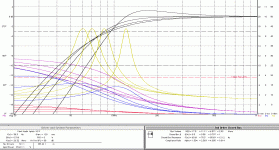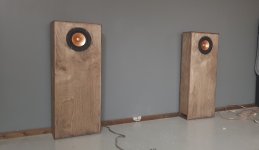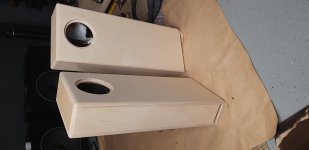Hi,
I already build Woden design Poplars for Alpair 10.3. That is a great design. But wondered more unorthodox design, I have other pair of Alpair 10.3 drivers and also some old JBL 2226H 15" woofers.
There is efficiency difference of approx 10db between drivers (Alpair: 87,5db and JBL:97db)
If front baffle width is 38cm, the baffle step frequency is approx 305Hz and thats also XO point. Alpair will be in its own sealed chamber. Now, do you see any problems if I flatten efficiency difference between drivers in digital domain using Roon player which has paramteric EQ functions with shelving filters? Rest is done via passive XO.
I was thinking if I could get great midbass slam and impact of 15" driver and delicate coherence of fullrange in same package.
I already build Woden design Poplars for Alpair 10.3. That is a great design. But wondered more unorthodox design, I have other pair of Alpair 10.3 drivers and also some old JBL 2226H 15" woofers.
There is efficiency difference of approx 10db between drivers (Alpair: 87,5db and JBL:97db)
If front baffle width is 38cm, the baffle step frequency is approx 305Hz and thats also XO point. Alpair will be in its own sealed chamber. Now, do you see any problems if I flatten efficiency difference between drivers in digital domain using Roon player which has paramteric EQ functions with shelving filters? Rest is done via passive XO.
I was thinking if I could get great midbass slam and impact of 15" driver and delicate coherence of fullrange in same package.
Not familiar with Roon - so would be happy to be corrected - but I’d be inclined to a bi-amped approach myself, with either active or passive line level XO. Of course that’s based on my limited experience with this type of 2-way system. To be honest, the last big one was the A12PW/A7.3 that Dave sometimes posts a picture of, and I ended up preferring a passive speaker level network designed by a friend using LinearX LMS/LEAP software.
Woden design Poplars for Alpair 10.3
I drew it, but have not heard it, can you tell us more?
dave
There is efficiency difference of approx 10db between drivers (Alpair: 87,5db and JBL:97db)
If front baffle width is 38cm, the baffle step frequency is approx 305Hz and thats also XO point. Alpair will be in its own sealed chamber.
I would suggest that bii-amping would be better than EQ. And better and cheaper.
I have found that when using the XO point to deal with BSC, the turnover point should be (0.707 to 1) times the nominal BSC F(-3dB). Usually closer to the lower number.
Also try to keep the centre-to-centre distance less than a 1/4 wavelength of the XO frequency (which essentially means the drivers become coincident).
With careful design one can get away with 1st order XOs, which given the “coincident” nature of the drivers (given the spacing suggested) one gets very vlose phase linearity without doing anything else.
I would at least add a coat of thinned “puzzlekoat” on the JBLs. I did this back in my pro days for a noticable reduction in cone self-noise. If you add enuff you can reduce the driver’s efficiency a bit and decrease its resonance frequency.
See the attached sealed sim to get an idea of how big to make the A10.3 box. For WAW i usually go further and do a midTL for the midTweeter.
dave
Attachments
… the A12PW/A7.3 that Dave sometimes posts a picture of, and I ended up preferring a passive speaker level network designed by a friend using LinearX LMS/LEAP software.
This passive XO cost us more than the PLLXO & extra amps cost (and active a whole lot easier, even with the passive aided by the 2 parallel A12pw having just the right sensitivity to match the A7.3eN). I have been listening to tham with the passive XO since they were installed at diyFEST over a year ago.
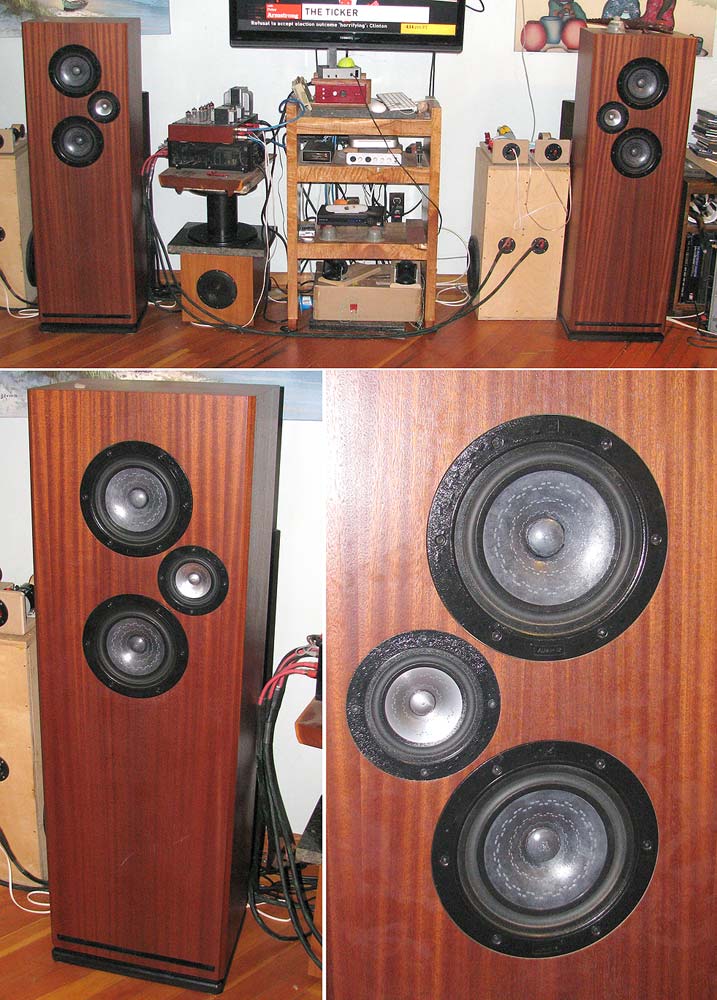
The passive sounds good, but i can’t help but think that by using the passive XO, chris then has the amp channels for his height surrounds which he says adds a lot to a movie.
dave
I’ve concluded that as convenient as the digital XO / biamp functionality on the Onkyo might have been for FAST experimentation with 2ways, the sonic quality was definitely lacking. And while I’d agree that PPLXO / active can sound wonderful, the two speaker XOs that Aaron designed were an exercise in the efficacy of passive networks vis a vis the several other approaches we played with.
With more forethought than we gave the project, they could’ve been fit inside, but I wasn’t inclined to ripped those finished enclosures apart - there was probably 20hrs and certainly over $250 in materials for the veneer and finishing.
Then there’s the fact that costs notwithstanding, we need to accept that some folks just want to avoid the complexities of active / multi-amping - at this point in life I’ll count myself in that cohort. And yes, as I watch movies more than listening to movies these days, the height and rear surrounds are worth it for me.
With more forethought than we gave the project, they could’ve been fit inside, but I wasn’t inclined to ripped those finished enclosures apart - there was probably 20hrs and certainly over $250 in materials for the veneer and finishing.
Then there’s the fact that costs notwithstanding, we need to accept that some folks just want to avoid the complexities of active / multi-amping - at this point in life I’ll count myself in that cohort. And yes, as I watch movies more than listening to movies these days, the height and rear surrounds are worth it for me.
Last edited:
I think that will be an excellent combination and I would not worry about the extra sensitivity of the woofer. It's not that sensitive at the frequencies you'll be using it and consider it's extra oomph to be your baffle step correction. I would also consider leaving the back of you Alpair box open. Offers quite a nice airiness to the system.
There is efficiency difference of approx 10db between drivers (Alpair: 87,5db and JBL:97db)
For a passive XO to work out you typially want a maximum of 6 dB more sensitivity of the woofer over the midTweeter and i typically look for about 3dB.
dave
Not familiar with Roon - so would be happy to be corrected - but I’d be inclined to a bi-amped approach myself, with either active or passive line level XO. Of course that’s based on my limited experience with this type of 2-way system. To be honest, the last big one was the A12PW/A7.3 that Dave sometimes posts a picture of, and I ended up preferring a passive speaker level network designed by a friend using LinearX LMS/LEAP software.
I have to study PLXXO, its not familiar to me. Other option: could I connect woofer part of speaker level XO to one amp and fullrange XO parts to second and adjust gain down from woofer amp to level volumes (using mic and REW) and then control overall volume from preamp?
Original Roon option:
Roon cannot be used to make separate LP and HP for different channels, just global EQ. I has very good sound and I have noticed its EQ´s sound quality is night and day difference compared to my old PA 32-band graphic EQ which always steals resolution and sound weird. When using Roon I am unsure if it makes somekind of phase problems etc. in XO frecuency (when using passive XO) if using shelving filters with it when trying to level volume of 15" 2226H woofer.
Do you mean PLXXO or using passive XO speaker level bi-amping?I would suggest that bii-amping would be better than EQ. And better and cheaper.
Originally written by😛lanet10 Also try to keep the centre-to-centre distance less than a 1/4 wavelength of the XO frequency (which essentially means the drivers become coincident).
So as near as possible. I can use kerfed MDF inside box and make custom chamber for Alpair. Regarding sealed volumes in your chart, 6,5L would be enough if using 300hz XO point?See the attached sealed sim to get an idea of how big to make the A10.3 box. For WAW i usually go further and do a midTL for the midTweeter.
Originally written by😛lanet10 I would at least add a coat of thinned puzzlecoat on the JBLs. I did this back in my pro days for a noticable reduction in cone self-noise. If you add enuff you can reduce the driver’s efficiency a bit and decrease its resonance frequency.
Interesting, I think Dammar varnish could work also. Its used for paintings and is available locally.
I drew it, but have not heard it, can you tell us more?
dave
That is great to hear! These were my first fullrange build. Needed shallow enclosure for my small sauna cottage and when searching options decision was clear when founded them: shallow, can be placed to near wall.
I made them from birch plywood. They sound great and bass is surprising, everybody who has heard them has been amazed how two small drivers can make such bass. Bass is accurate and not bloated, kind of "HD" bass compared to my earlier speakers.
Thanks, thats couraging!I think that will be an excellent combination and I would not worry about the extra sensitivity of the woofer. It's not that sensitive at the frequencies you'll be using it and consider it's extra oomph to be your baffle step correction. I would also consider leaving the back of you Alpair box open. Offers quite a nice airiness to the system.
I need to make enclosure and do measurements to see how much there is need for reducing sensitivity. About leaving box open, I could make removable piece of plywood at the back of enclosure to test this out.
Attachments
Last edited:
Roon … just global EQ
I wa sthinking about that today… is it parametric? Can you create a shelf? Maye with a dip in-between.
Do you mean PLXXO or using passive XO speaker level bi-amping?
A passive crossover to be placed before the parts. In the simpliest version a single cap per channel in front of the midTweeter amp (value a function of desired XO frequency and teh am’s input impedance), and an R with a C shunt to ground for the low pass.
TLS.org | Passive Line-Level Crossover
Regarding sealed volumes in your chart, 6,5L would be enough if using 300hz XO point?
I tend to like a bit bigger but 5 litre stuffed shoud be good. If sealed XRK’s "dagger shape" is good.
Interesting, I think Dammar varnish could work also. Its used for paintings and is available locally.
I found one has to be very careful with damar… too much can cause significant cone resonances at higher frequencies. It tends to stiffen stuff up. The “puzzlekoat” remains flexible, but still seals the surface of the paper cone.
dave
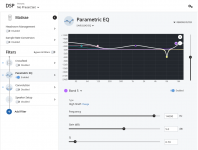
I was thinking about that today… is it parametric? Can you create a shelf? Maye with a dip in-between.
Yes its possible, see attachment pic. I think this could be first option to try besides PLXXO which are strange/new for me.
So Roon EQ for level matching and passive XO doing slopes at 305Hz..
Also try to keep the centre-to-centre distance less than a 1/4 wavelength of the XO frequency (which essentially means the drivers become coincident).
This criteria can be achieved. 1/4 wavelenght of 305Hz is 28cm. When drivers are tightly placed, distance from center to center is 27,2cm.
Concerning enclosure for JBL 2226H, which needs to be done first, diyaudio user "Inductor" mentioned this suggestion in other thread:
"From what you say you want a tight musical sealed enclosure/speaker. I can post for you one (BR) that will be similar (tight/ideal) with a fair response in frequency, in musical/jazzy terms, this is possible. And this alignment would give you a fair response (sub) usually not used in 3-Way speakers of small dimensions."
JBL 2226H
Reflex enclosure (net) 82L@39Hz, plus add the volume for driver and port.
Port: 15.0 cm diameter/32.25 cm lenght
F3@57 Hz
F12@32 Hz
Source: jbl 2226hpl closed box?
----
Im tempted to proceed with this. Port could be plugged if bass response is not fun enough and then EQ:ing can be added. If anyone have other enclosure ideas for JBL 2226H I will listen. No restrictions for size.
Last edited:
It's definitely a fine alignment, but limited WRT EQing, so for lower Qt drivers I normally used/recommend Vas tuned to Fs or at minimum, the pioneer's 147.74 L [Vas]/1.44 = ~121.5 L, which is the balanced trade-off between size, power handling, gain BW.
Worst case sealed Qtc and least EQ options is of course the smallest cab, though in-room, doubtful the average person would be able to tell much, if any, difference = ~0.58 [82 L], 0.51 [121.5 L], 0.48 [147.74 L].
GM
Worst case sealed Qtc and least EQ options is of course the smallest cab, though in-room, doubtful the average person would be able to tell much, if any, difference = ~0.58 [82 L], 0.51 [121.5 L], 0.48 [147.74 L].
GM
It's definitely a fine alignment, but limited WRT EQing, so for lower Qt drivers I normally used/recommend Vas tuned to Fs or at minimum, the pioneer's 147.74 L [Vas]/1.44 = ~121.5 L, which is the balanced trade-off between size, power handling, gain BW.
Worst case sealed Qtc and least EQ options is of course the smallest cab, though in-room, doubtful the average person would be able to tell much, if any, difference = ~0.58 [82 L], 0.51 [121.5 L], 0.48 [147.74 L].
GM
Thanks, I could try Vas tuned to Fs (40Hz) It will be 175 liters then.
Front baffle width would be 38cm (15") D: 65cm (25,5") H: 94cm (37")
Could this design be ruined by positioning woofer at wrong distance from floor, and getting floor bounce that messes LF response? Any suggestions for good position?
You're welcome!
Yes, though frankly, never paid much attention to floor bounce since getting the components up to seated/whatever ear height and even more importantly, at an odd harmonic [peak] of the room height with the listening position at an odd harmonic of the room, is far more important IME.
So many times I've been in folk's rooms where these two were not matched up, so in many cases they were using [far] more power than necessary due to excessive EQ.
These's a local with a huge [4] way horn system in a relatively large room that once the separate systems were properly located he was able to remove all EQ except for the obvious SPL level matching and once digital time delay was done he had a nominally flat amplitude, phase response in stereo from ~16 Hz -22 kHz, i.e. can reproduce a square wave, the requirement to accurately reproduce music.
Note that this is a single seat system and Rythmik Audio servo subs or similar required to get the low end to match up to the compression loaded bass horns unless of course you have the room, etc., for compression loaded infrasonic subs 😉.
GM
Yes, though frankly, never paid much attention to floor bounce since getting the components up to seated/whatever ear height and even more importantly, at an odd harmonic [peak] of the room height with the listening position at an odd harmonic of the room, is far more important IME.
So many times I've been in folk's rooms where these two were not matched up, so in many cases they were using [far] more power than necessary due to excessive EQ.
These's a local with a huge [4] way horn system in a relatively large room that once the separate systems were properly located he was able to remove all EQ except for the obvious SPL level matching and once digital time delay was done he had a nominally flat amplitude, phase response in stereo from ~16 Hz -22 kHz, i.e. can reproduce a square wave, the requirement to accurately reproduce music.
Note that this is a single seat system and Rythmik Audio servo subs or similar required to get the low end to match up to the compression loaded bass horns unless of course you have the room, etc., for compression loaded infrasonic subs 😉.
GM
You're welcome!
Yes, though frankly, never paid much attention to floor bounce since getting the components up to seated/whatever ear height and even more importantly, at an odd harmonic [peak] of the room height with the listening position at an odd harmonic of the room, is far more important IME.
GM
OK! I decided to mount 15" woofer so that its center is 40cm (15,7") from the floor. If Alpair is positioned above woofer as nearest as possible, Alpairs height from the floor will be almost same as in Poplar design, and that works already concerning Alpair.
I try this design first at 82L (2,9cuft) @39Hz vented enclosure mentioned in post #11. Just because old enclosures from broken Hifi 85/3 DIY speakers are available, Their volume is 85L) Those enclosures can be modified to larger so displacement of 15" driver, Alpair chamber and vent are taken account.
Even the width of those old enclosures suits for original plan: 38cm (15")
- Home
- Loudspeakers
- Full Range
- FAST / WAW: Alpair 10.3 and 15" JBL 2226H
